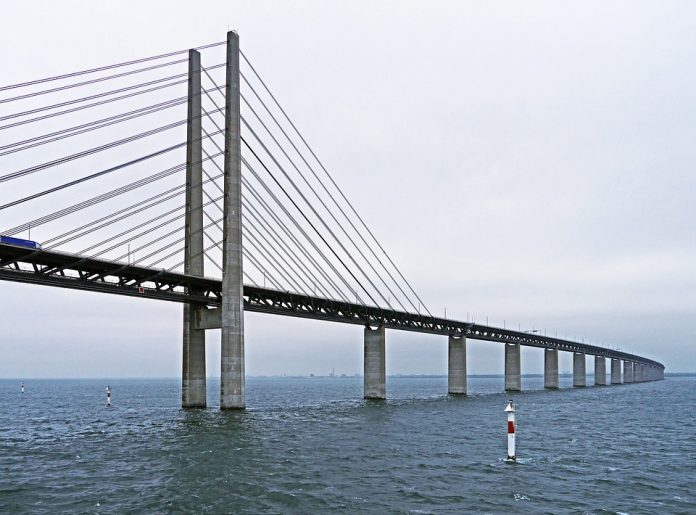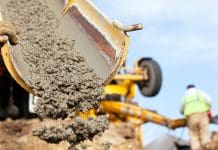In his latest article, James McDonald of Cementaid looks at the issue of curing concrete, structural defects and the importance of knowing how to avoid problems occurring in the first place
One of the good points about the latest version of British Standard BS 8102:2009 (Code of practice for protection of below ground structures against water from the ground) is that it brings up the subject of ‘repairability’. Given that all forms of waterproofing are installed by humans, there are bound to be errors or deficiencies in some installations. The standard therefore raises the issue of how repairs will be carried out if the waterproofing fails.
Take a membrane, for example, applied to the face of contiguous piles following which a reinforced concrete lining wall is placed sandwiching the membrane between this wall and the piles. Suppose a leak appears through a crack in the lining wall indicating that the membrane has failed. Except by breaking out the lining wall, there is no way to get to the membrane to fix it.
Apart from anything else, the defect in the membrane may be a long way from where the crack is. So in practice, the defect in the membrane cannot be corrected. At best, a concrete repair can be carried out to seal the leak.
However, now that water has breached the membrane, unless the concrete includes a damp-proofing concrete admixtures, water will be sucked into and through the concrete until it is completely saturated. If the dampness on the inside face of the lining wall can evaporate, there will be a continuous flow of water through the concrete. The issue then is that the water may contain chlorides or sulfates, which over time could create a serious problem.
In general, the most common defects in concrete allowing water penetration, excluding structural issues, are: honeycombing (uncompacted concrete usually caused by inadequate or incorrect compaction); unfilled or incorrectly filled tie-bolt holes; around or through service penetrations not properly installed or sealed; at construction joints usually due to poor joint surface preparation and/or inadequate compaction of concrete at joints; and cracks. Except for the last item, all these defects are manmade. The good news is that they are all easily corrected by simple concrete repair work.
There is a general belief that all concrete cracks and the proof given is that engineers design reinforced concrete to a maximum crack width. This is a myth. Cracks in concrete can be caused by numerous factors but in simple terms, only when the tensile strength of the concrete is exceeded by the tensile strain imposed on it will the concrete crack. The design intent for the concrete used in the building of the Øresund crossing was that it would be a “crack-free” structure.
Now the subject of cracks is a book in itself but when dealing with “quality” concrete that has been properly placed and compacted, cracking is principally caused by two factors: inadequate curing and restraint.
Curing is something that is often talked about but seldom done. Testing carried out by the National Research Council of Canada in the late 1990s indicates that concrete, made with Portland cement without cement replacements, fully cured for four complete days will have gained enough tensile strength to resist cracking due to drying shrinkage. However, if the commencement of the curing of concrete is delayed even by a few hours, micro-cracking may occur and these cracks will become more apparent as the concrete continues to dry out.
Curing is the protection of concrete to prevent water evaporation and to protect it from wind, direct sunlight, frost and high temperatures. The length of time over which curing should take place is usually laid down in the concrete specification and is dependent on ambient temperatures.
In simple terms, water encased in concrete is, in effect, a solid that cannot be compressed. If water is allowed to evaporate from the concrete, the volume of concrete will reduce, and as the cement hydrates and binds and pulls the aggregate together, cracks will occur to relieve the stress.
Now all materials when ‘broken’ will try and break into squares. So a concrete wall 10m long by 2.5m high will try to break into four sections. In practice, this is only a rough guide as there are other factors that may come into play.
Restraint cracking is often seen where there is “end” restraint, for example, the top deck of a multi-storey car park where the concrete deck is placed on walls where the deck is tied into the walls with continuous reinforcement.
Many materials, for example paper or cotton cloth, are very difficult to rip apart unless you first create a minor tear and then they are easily torn apart. Concrete is exactly the same. A ‘hard point’ like a column supporting a deck is often where a ‘tear’ will occur in the deck.
Now if that deck is subject to temperature changes, as the temperature rises that crack will close, but when the temperature falls, say below freezing, the deck will be trying to shrink but it is restrained and, as a result, the tear will elongate to relieve this stress. This process will slowly continue until the crack runs out of concrete!
Of course, not all concrete decks are exposed but this is an issue where the concrete is exposed and many of us park in multi-storey car parks which tend to be open to the elements, especially the top deck which is exposed to direct sunlight.
To avoid such cracking, the concrete elements must be designed to relieve stress as far as is reasonably practicable. In general, there are five actions that can be taken to do this: incorporate movement joints; include slip membranes; allow for pour strips; limit the aspect ratio (ie length to width or length to height) and limit the overall pour size.
As stated in the Institution of Structural Engineers guidance Design Recommendations for Multi-Storey and Underground Car Parks: “While thermal movement can create joint movement in one direction or plane, there is also the potential for simultaneous movement in other directions which the joint movement system must accommodate.
“In some instances, in addition to the sideways movement created by normal thermal expansion and contraction of a concrete slab, there is also torsional/rotary movement, which can be created by the influence of other parts of the structure or from dynamic loading.”
It is also vital to remember that in assessing the need for removing thermal stresses, consideration must be given to the fact that although once completed, many of the concrete elements will not be exposed to significant temperature variations, during construction they will be.
Slip membranes are useful as they allow concrete elements to move independently of each other, eg a deck sitting on a wall or support beam.
However, in the UK there is a general reluctance to specify either movement joints or slip membranes. This may be unfortunate as where an element needs to move and is allowed to freely move, it should last a lot longer than making that element rigid by increasing the amount of reinforcement and concrete used which may have other consequences.
Pour strips are useful for relieving stress caused by drying shrinkage where bays of concrete are placed leaving a small gap between each bay. Some days later, the gap around the bays is then filled in. The delay in filling the gaps depends on a number of factors but in certain circumstances, for example a very long building of 80m or more, experts usually recommend as much as 30 days. Generally, the bays should have an aspect ratio of close to 1:1 and should not be tied into any surrounding elements, thus allowing the concrete to freely shrink without restraint.
Limiting the aspect ratio reduces the stress in the longer plane and makes the concrete less vulnerable to the ‘split into squares’ principle noted above.
However, beyond a certain size, this principle is unlikely to apply and therefore it is common for the design to restrict the maximum pour size.
The incidence of cracking in UK concrete structures is so prevalent that it is not surprising the general public believes that all concrete cracks, in reality, almost all cracks are avoidable.
Take two actual quotes from site managers, one was asked how he intended to cure the concrete: “We’re going to use natural curing and let the sun dry the concrete”.
The other involved shrinkage cracks in a concrete lining wall to secant piles where the question asked was how did you cure the walls? “I couldn’t cure the walls because I couldn’t get behind the piles!” When asked what he thought curing was, he admitted he hadn’t a clue. Time to return to the days of the resident engineer, I suggest.
In summary, whereas structural defects in concrete are often difficult to repair, most others are easily fixed. If a damp-proofing additive has been included in the concrete, the waterproofing will be reinstated and water, by capillary absorption, will not be able to permeate laterally through the concrete potentially causing dampness, mould growth and other water ingress issues.
However, it would be much better if these issues were avoided in the first place as it would not cost any more in time or money. It is a pity that experience would suggest that many of these defects are down to lack of proper training and supervision on site and a poor knowledge and understanding of what good concrete practice is.
James McDonald
General manager
Cementaid
Tel: +44 (0)1293 653 900







![[VIDEO] UK-based firm reveals ‘world’s first’ fully AI-driven architectural project Studio Tim Fu has revealed the 'world's first' fully AI-driven architectural project in Slovenia, developing six luxury villas on the Lake Bled Estate](https://www.pbctoday.co.uk/news/wp-content/uploads/2025/03/Interior-1-studio-tim-fu-218x150.gif)






